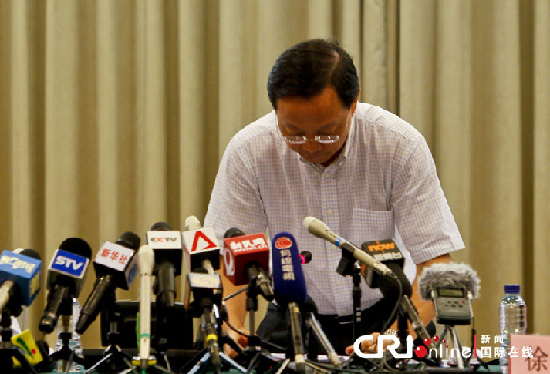Firm behind signaling system has had glitches
 0 Comment(s)
0 Comment(s) Print
Print E-mail
Shanghai Daily, September 28, 2011
E-mail
Shanghai Daily, September 28, 2011
|
|
|
The Shanghai municipal government holds a news conference over the subway crash accident on September 27, 2011. Yao Yuguang, head of the train company bows and apologizes.[Photo/CRI] |
Behind yesterday's crash, an equipment provider with a troubled history soon surfaced to arouse more public concern.
It wasn't the first time that signal failure caused trouble on the city's ever-expanding Metro system. Line 10 was put into service in April last year.
The signaling system that malfunctioned and led to yesterday's accident was designed by Casco Signal Ltd, a key supplier that was also blame for the fatal bullet train collision in Wenzhou on July 23, killing 40 people.
Casco, the joint venture founded by China Railway Signal and Communication Corporation and Alstom (China) Investment Company Ltd in 1986, has provided the signal system to Shanghai's Metro Lines 1, 3, 4 and 10.
The signaling system, Communication Based Train Control system (CBTC), in use on Metro Line 10 trains was believed to be "currently the most advanced signaling system in the world" and "would be widely used on other Metro lines after testing," according to a previous Shanghai Daily interview with Metro operators.
Reassurances offered
In addition to providing the signal equipment along the Wenzhou train track that saw the July 23 collision, Casco has set up similar equipment on other railway lines, including the high-speed Shanghai-Beijing line.
But Wang Jingwei, a manager with Casco who was on the Line 10 project, told Shanghai Daily yesterday that the Metro Line 10's signaling system was different from that used on the bullet train.
Wang said the reason for the crash was under investigation.
Casco's record of signal problems dates to late 2009. A signal circuit glitch led to two trains on Metro Line 1 colliding on December 22, 2009 with no casualties. Casco was punished for that incident.
Staff from the company had wrongly laid out wire in a signal circuit in 2001 when the line was extended.
In an incident in July, also on Line 10, a train that should have been heading for Hangzhong Road instead took the other track at a Y-shaped intersection and ended up at Hongqiao Railway Station.
Yu Guangyao, the board of chairman of Shanghai Shentong Metro Group, which runs the Metro, said his firm got reassurances from Casco after the glithes in July.
"Casco then promised to us that such signal problems would not happen again," said Yu. "We wanted to know what going on."
Shentong told Shanghai Daily after July's accident that the error occurred when the operators were upgrading and testing the new CBTC signaling system. But it was a test on a train full of passengers.
Metro officials explained that they had been testing the system with empty trains, but they needed to gather information with certain passenger flows in order to debug the system.
The Metro operator guaranteed later that the testing was safe and would prevent collisions.







Go to Forum >>0 Comment(s)